Leucanthemum x superbum
Shasta daisies occupy a quiet corner of my mind. I remember the glow of white flower petals in my parents’ garden at night, reflecting the moonlight as we roasted hotdogs on bonfires and hunted for fireflies.
Daisies as a group are garden favorites. The Shasta variety is no exception, and not only for its big bloomed, beautiful looks. This perennial is sturdy, easy to grow, and very versatile.
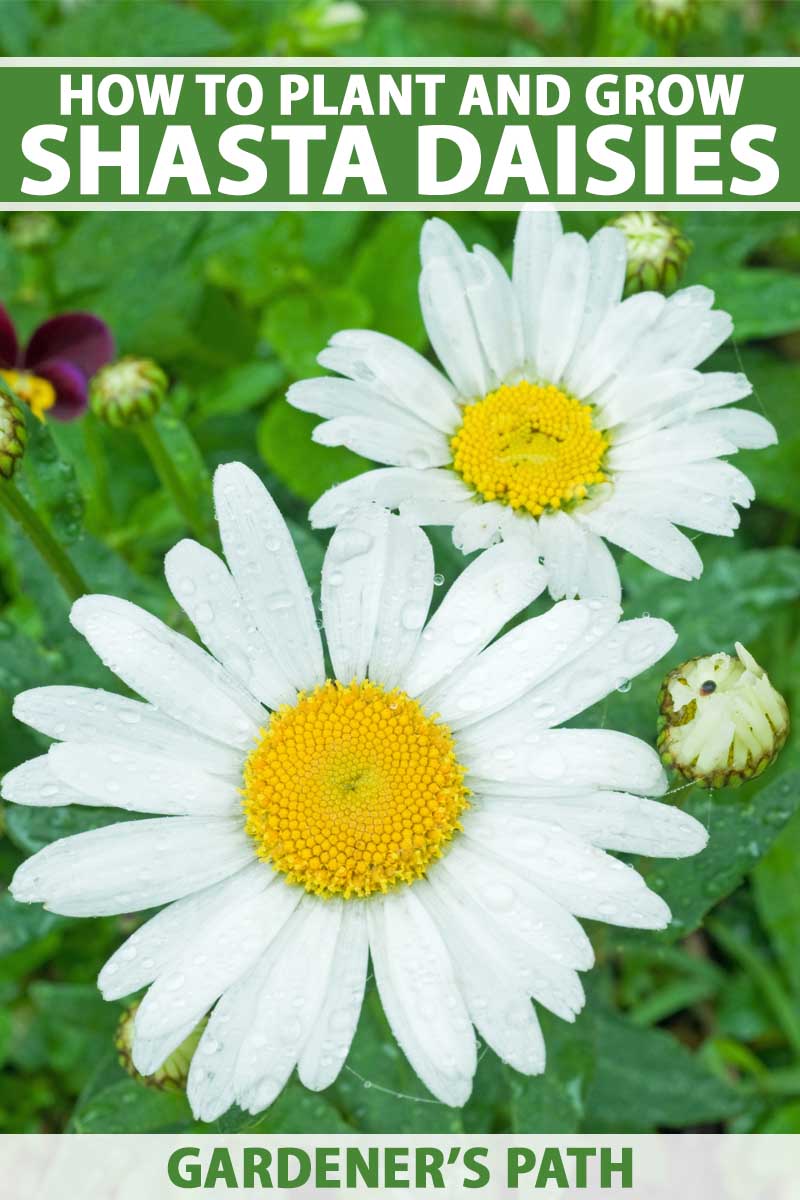
We link to vendors to help you find relevant products. If you buy from one of our links, we may earn a commission.
Suitable for cultivation in USDA Hardiness Zones 4 to 9, they bloom in midsummer and are a favorite for cottage gardens or perennial borders.
Ready to add Shasta daisies to your garden? Here’s what I’ll cover:
What You’ll Learn
Cultivation and History
Shasta daisy is a member of the Asteraceae or aster family, a group noted for its starburst-shaped flowers.
Plants in the Leucanthemum genus are native to Europe and Asia, but the Shasta daisy itself is American.
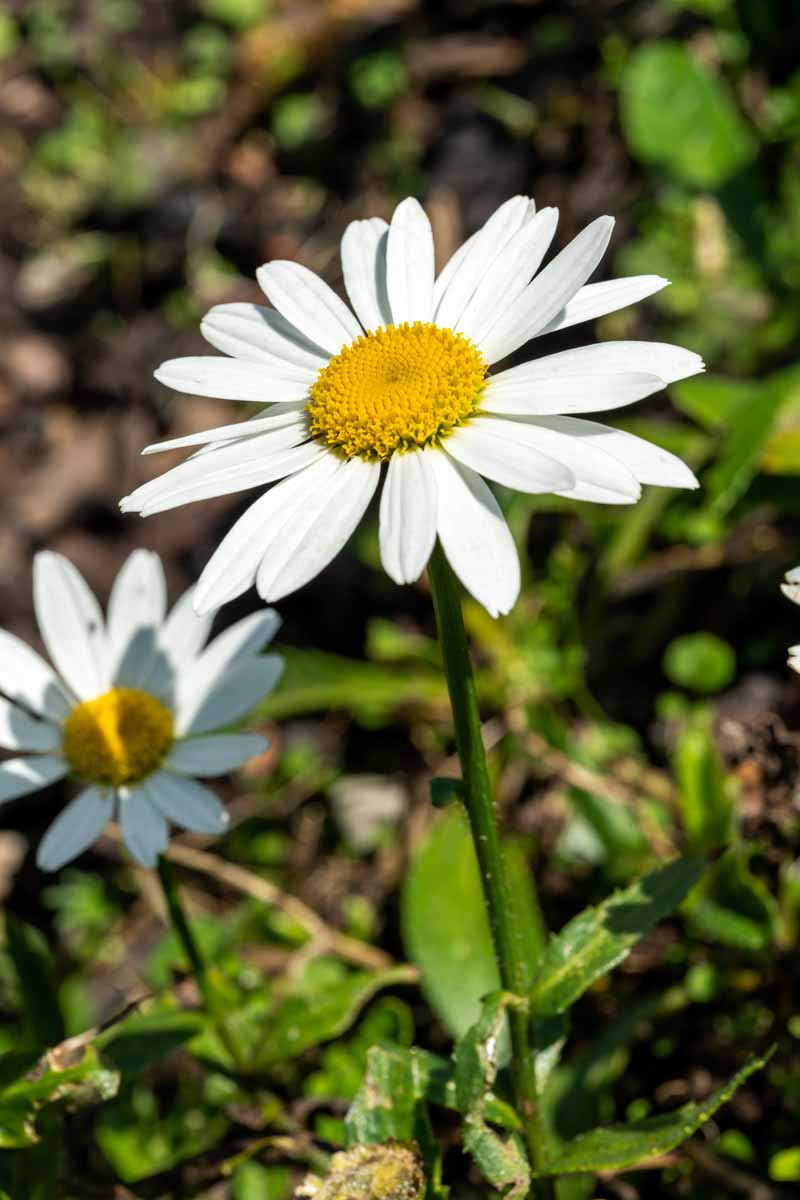
Developed near snowy Mount Shasta in Northern California, Shasta daisies are the result of a quadruple hybrid cross.
The parents, L. vulgare (oxeye daisy), L. maximum (English field daisy), L. lacustre (Portuguese field daisy), and Nipponanthemum nipponicum (Japanese field daisy) were crossed over a period of 17 years by horticulturalist Luther Burbank, starting in 1884.
Finally, in 1901, looking like a beautiful sunny side up egg, the Shasta daisy was introduced to home gardeners.
It looks very similar to the oxeye daisy, but the flowers are much larger.
Shasta Daisy Propagation
Shasta daisies are easy to propagate from seed and by division. Note that as a hybrid, seeds saved from existing plants may not grow true to the parent.
From Seed
Sow seeds indoors either in individual pots or trays eight to ten weeks before the average last frost date in your area.
The seeds need light to germinate and should be gently pressed into a moist soilless medium but not covered. The seeds will germinate within 14 to 21 days if kept at 70°F in a bright spot.
After germination, provide even moisture and maintain the seedlings in a sunny location. When plants have two sets of true leaves and all risk of frost has passed, you can harden off and transplant into the garden, as described below.
Alternatively, sow the seeds into containers outdoors or directly into the ground in May, or from mid August to early September. Sow in groups of three or four seeds spaced 12 to 24 inches apart.
After they germinate, thin the seedlings to keep only the strongest and healthiest looking plants.
When sown in the spring, some cultivars will bloom the same season, while others will bloom the following year.
By Division
Dividing your plant is an important part of maintaining its vigor. This is an easy way to propagate more Shasta daisies for your garden if you are already growing some, or if a friend or neighbor has a few to share.
Plan to divide existing plants every two to three years, in early spring or late summer. Digging at least six inches from the crown and 12 inches deep, remove the plant carefully from the ground with a spade or shovel.
Shake the soil from the roots, and divide the roots in half or into thirds with a clean knife or pruning shears. Each division should have a few stems and plenty of healthy-looking roots attached.
Replant as outlined below.
Transplanting
If you bought potted plants from a nursery or grew your own seedlings indoors, plant them in the spring or early fall. Make sure the soil you are planting into is moistened and well drained.
Plants can have an 18-inch spread when mature, to be sure to space them at least this distance apart.
Dig a hole that’s twice the width and depth of the container. Work two to four inches of compost into the bottom of the hole, and check that the top of the root ball will be at the soil level once planted.
Insert the root ball, fill in the gaps with soil, and firm with your hands.
Water thoroughly after planting and apply a layer of mulch to keep weeds down.
How to Grow Shasta Daisies
Hardy in Zones 4 to 9, Shasta daisies are robust, easy perennials to grow. They bloom in the summer, from July to September, and are low maintenance.
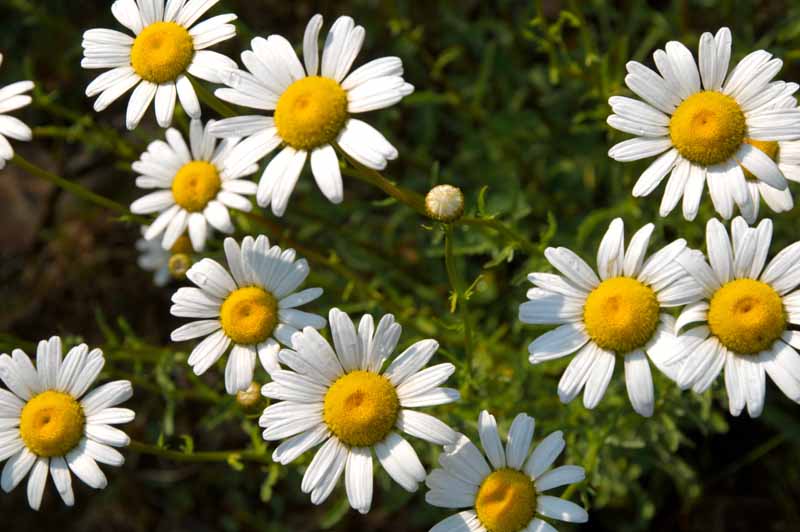
Plant in full sun for loads of blinding-white flowers with sunny centers. Partial shade is okay in hot climates.
They prefer well draining, moderately fertile soil, with a dry to medium moisture level.
They’ll thrive in a wide variety of soil types, including chalk, clay, loam, and sand. A pH of 5.5 to 6.2 is ideal, but these flowers will tolerate a neutral pH as well.
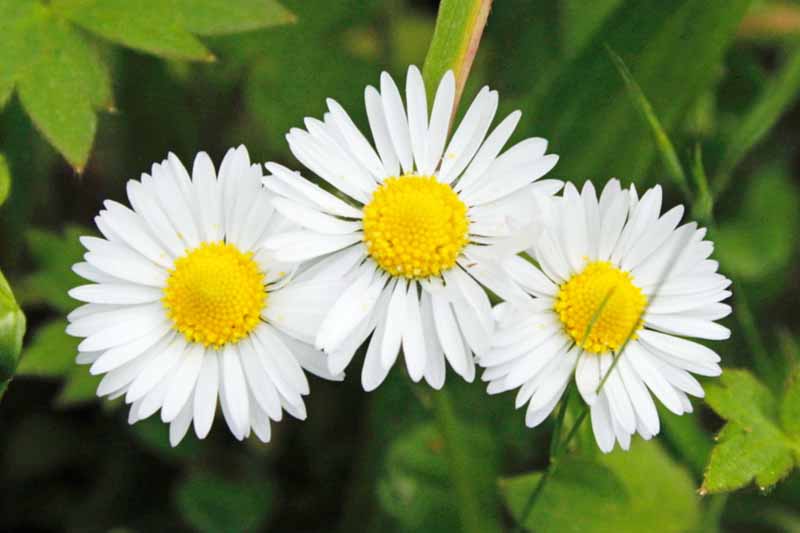
Shasta daisies are drought tolerant once established, but should be watered during the summer if the accumulated rainfall has been less than one inch per week. Not sure how much you’re getting? Try a rain gauge.
Apply a layer of compost in the spring to keep fertility up for optimal growth.
Beyond the application of compost at planting time and annually in the spring, Shasta daisies don’t need to be fertilized, as too much nitrogen fertilizer will cause the plants to produce more vegetation than flowers.
Growing Tips
- Plant in full sun.
- Provide well draining soil.
- Amend with compost at planting time and each spring to follow.
Pruning and Maintenance
Remove spent flower heads if you want to promote continual blooms throughout the season.
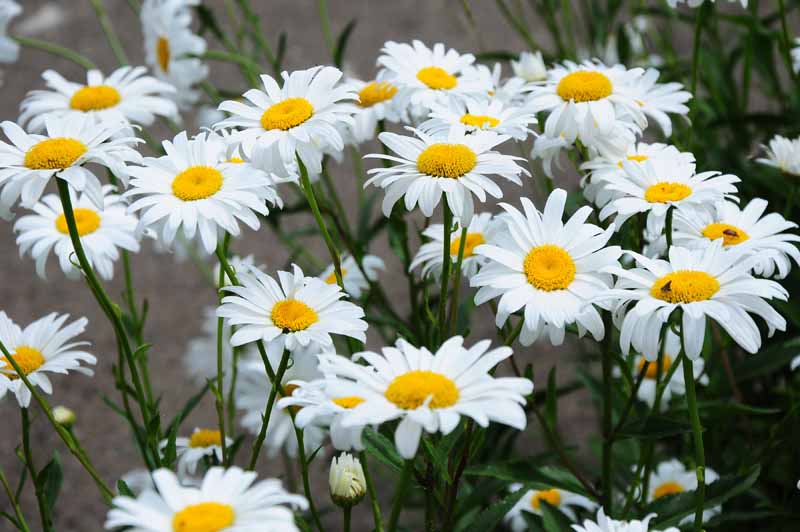
Shasta daisies produce flowers at the terminal end of the stem as well as laterally. When the terminal flower is spent, make your cut just above the junction with the lateral flower.
When you notice decreased vigor, smaller or fewer flowers, or the center of the clump begins to die, divide as described above to rejuvenate the plant.
If your plants fail to bloom, check out our troubleshooting guide.
After the first killing frost, prune the entire plant to one to two inches above the soil level.
Shasta Daisy Cultivars to Select
The thought of a Shasta daisy brings visions of pure white and sunshine yellow flowers contrasting with green stems and foliage, and for good reason.
But while most cultivars are true to the classic, there are some unique ones out there as well. Here are a few of my top recommendations:
Banana Cream II
This cultivar goes against the pure white Shasta daisy grain with lemon to pastel yellow petals surrounding the classic yellow center.
Part of the Amazing Daisies® series, it grows 15 to 18 inches tall with four-inch-wide blooms that will last over two weeks in a vase.
Plants are available at Burpee.
Becky
One of the larger cultivars, ‘Becky’ produces flowers three to four inches in diameter on three- to four-foot stems. The blooms are long lasting and make excellent cut flowers.
This variety was named Perennial Plant of the Year in 2003 by the Perennial Plant Association.
You can find this cultivar available at Nature Hills Nursery in #1 containers.
Crazy Daisy
Every family’s got one. Fittingly named, this frilly, feathery, eye-catching cultivar grows 23 to 27 inches tall. Fully double blooms have twisted white rays surrounding a yellow center.
Plants are available at Burpee.
Snow Lady
A dwarf version of ‘Becky,’ this cultivar only grows to 12 inches tall, making it a perfect container filler.
‘Snow Lady’ produces an abundance of two- to three-inch-wide white blooms.
Find ‘Snow Lady’ in #1 containers available at Nature Hills Nursery.
Managing Pests and Disease
Although Shasta daisies are sturdy plants and normally quite low maintenance, they can occasionally be bothered by a short list of insects and diseases, as follows.
Insects
While they can attract some lovely garden visitors, like butterflies, some of the insects that may visit are not as welcome.
Aphids
The small, squishy plant-suckers known as aphids are one of these unwanted pests. They can cause twisted leaves and reduced vigor, and leave sticky residues on upper leaf surfaces that can develop an ugly black mold.
If you notice an aphid issue, you can try applying an insecticidal oil such as Monterey Horticultural Oil, which is available at Arbico Organics.
Leaf Miners
Leaf miners are the larvae of small flies. As they chew twisting and turning tunnels inside the leaves of the plant, leaf miners cause disfiguring damage. If there are a lot of them, this can lead to defoliation.
If your plant is healthy, it can tolerate some minor leaf miner action. Remove leaves that show signs of infestation with the tunneling larvae, or crush the larvae at the ends of their tunnels to help control small populations.
Since the larvae are hidden inside the leaves, many pesticides labeled as safe for use in home gardens won’t be effective. Instead, why not try a biological control?
The beneficial nematode Steinernema feltiae can be a highly effective control when applied correctly.
It is available at Arbico Organics.
As these are living organisms, make sure to read the storage and application instructions carefully for the best results.
Learn more about beneficial nematodes here or more about controlling leaf miners here.
Two-Spotted Spider Mites
These tiny mites (Tetranychus urticae) can sneak up on you and have your plant webbed up and the green sucked out of it before you notice they’re even around, especially when it’s hot and humid out.
They like to hang around on the undersides of leaves, making them even harder to spot.
Keeping healthy plants is the first step in preventing a spider mite problem, but if an infestation does occur, try spraying the leaves with hard jets of water from the hose to wash the mites and their eggs off.
If this doesn’t help, you can try applying horticultural oil, such as the product mentioned above.
Disease
Spots and wilts can turn your beautiful Shasta daisy into an eyesore. Be on the lookout for the following:
Leaf Spot
Leaf spots on your plants can be caused by two different types of fungi, species in the Alternaria genus and Septoria leucanthemi.
Leaf spots are dark-brown round or semi-circular lesions with a white spot in the middle. Expect the spots to show up on the lower leaves first. Infected leaves might shrivel but will usually stay attached to the stem.
S. leucanthemi overwinters on plant material and is spread by splashing water. Remove diseased leaves as you notice them to reduce spread when it rains or when you water.
When you do water, try to water the base of the plant, not on the flowers and leaves. At the end of the season, get rid of any diseased plant material.
You can apply a product such as ZeroTol HC, available at Arbico Organics, to prevent and control leaf spot issues.
Verticillium Wilt
Verticillium wilt is caused by soilborne fungi Verticillium dahliae and V. albo-atrum, which infect the roots and can slowly spread through other areas of the plant.
An infection can cause symptoms such as sudden wilting, yellow leaves, stunted growth, and leaf loss.
The heat of the summer can help reduce the spread and severity of the disease.
You may decide to remove one affected plant to try to save your other plants, as these pathogens can affect over 300 other varieties of host plants, many of which are common garden ornamentals.
When dividing or pruning plants, take care to sanitize your tools.
Healthy, vigorous plants have the best chance of surviving this disease. Unfortunately, fungicides aren’t effective.
Best Uses for Shasta Daisies
Moonlight reflecting, sunshine rivaling Shasta daisies quickly became a garden favorite after their introduction to the market, and it’s no wonder.
This is one of the most versatile perennials you can grow, so you can get creative with it.
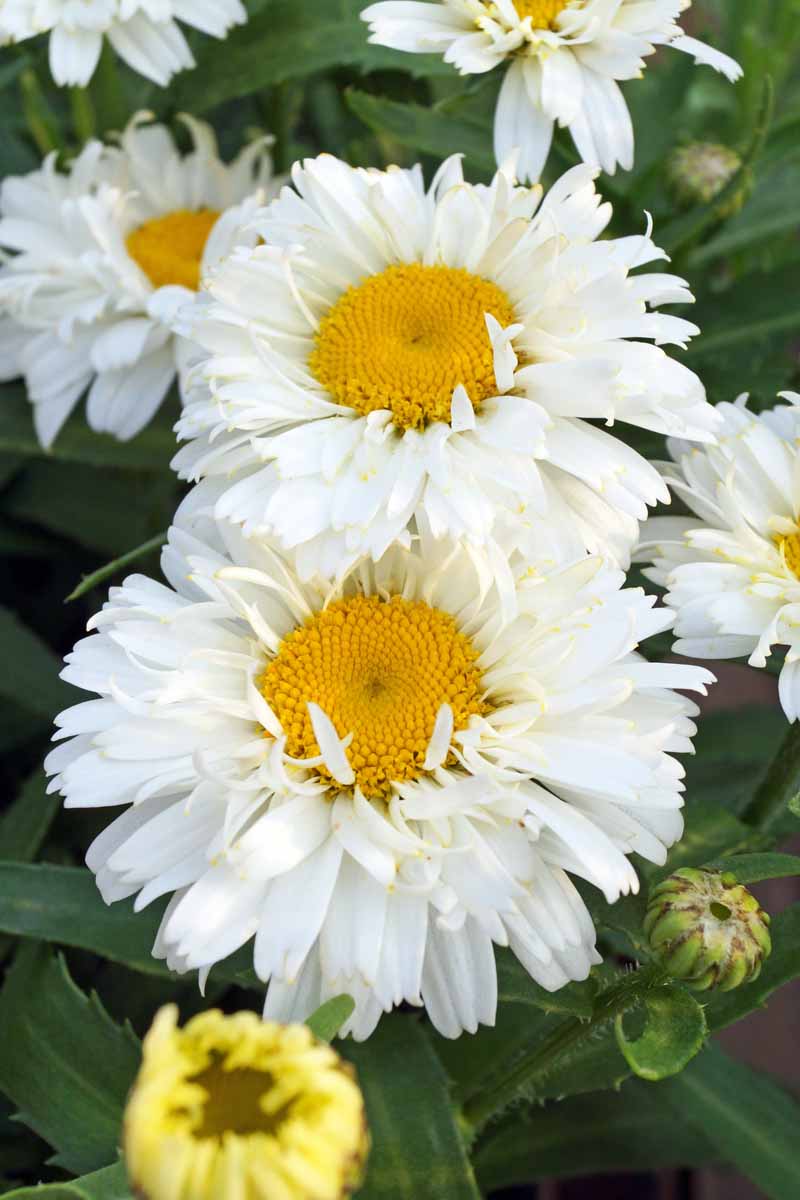
The long lasting, sturdy blooms are classics in cottage gardens and rock gardens, and you can plant them in rows, borders, and edges.
The clump-forming plants topped with white blossoms look great in mass plantings or as a single specimen.
Combine with other colorful perennials for stunning contrast, or plant in a cut flower garden and snip stems for over a week of beauty in a vase.
Quick Reference Growing Guide
| Plant Type: | Herbaceous flowering perennial | Flower / Foliage Color: | White petals, yellow centers/green |
| Native to: | Cultivated hybrid | Tolerance: | Deer, drought, rabbits |
| Hardiness (USDA Zone): | 4-9 | Maintenance: | Low |
| Bloom Time / Season: | Summer to fall | Soil Type: | Average |
| Exposure: | Full sun | Soil pH: | 5.5-6.2 |
| Spacing: | 1-2 feet | Soil Drainage: | Well-draining |
| Planting Depth: | Surface sow (seed), depth of rootball (transplants) | Attracts: | Butterflies |
| Height: | 2-3 feet | Uses: | Beds, borders, cottage, cut flower, rock gardens |
| Spread: | 18 inches | Order: | Asterales |
| Time to Maturity: | 1-2 years | Family: | Asteraceae |
| Water Needs: | Moderate | Genus: | Leucanthemum |
| Common Pests and Diseases: | Aphids, leaf miners, two-spotted spider mites; leaf spot, verticillium wilt | Species: | x superbum |
Sunny Side Up
Sure, lemonade is thirst quenching on those hot and hazy summer days, but Shasta daisy flowers will last way longer than a glass of lemonade will.
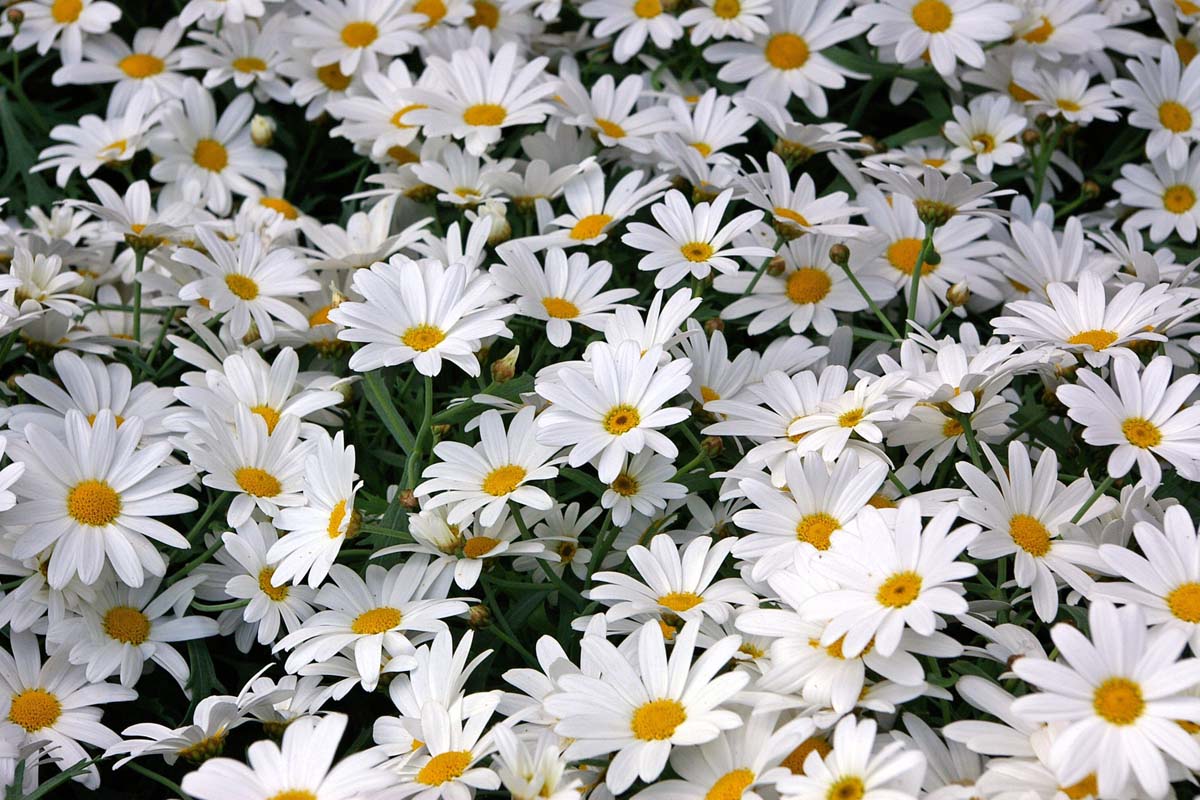
This showy, sturdy perennial is so versatile, adding exuberant color and vigor to your garden. Or, cut a few stems to brighten up a room in your house.
Did Shasta daisies make the cut for your garden? How are your plants performing? Let us know in the comments section below!
Learn more about how to grow and care for a variety of cheerful daisies next, starting with these:

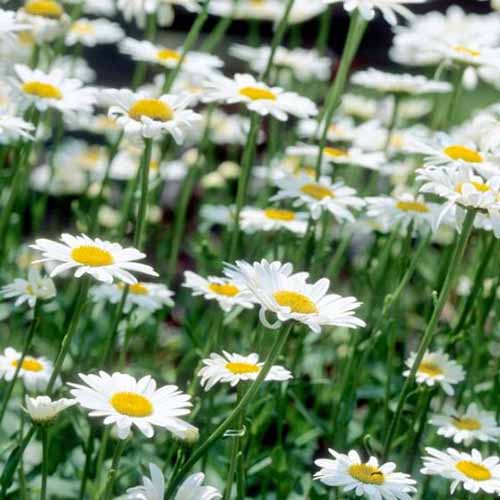
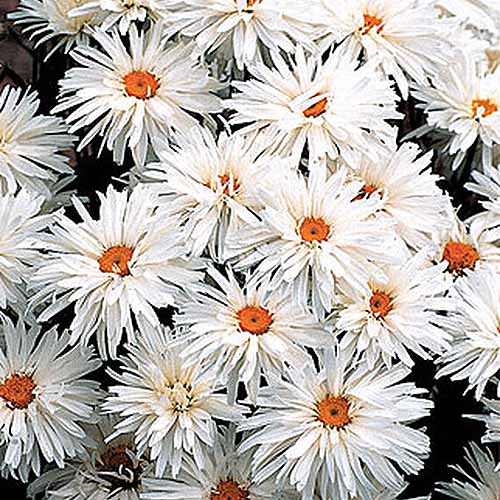

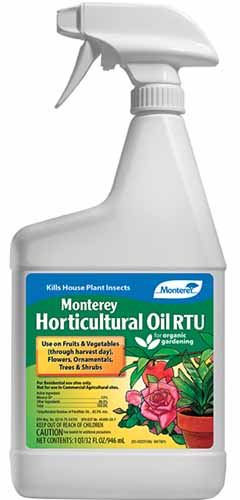


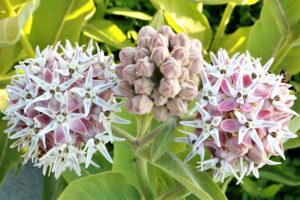
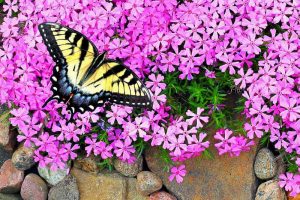
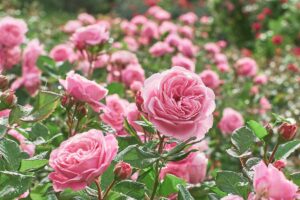
Thanks for the great info! I grabbed some “Alaska” variety seeds to try this year. It’s later than I wanted as took ages to get from Amazon source but thought I’d give them a try anyway. (; The plant I purchased locally died before I could even get it in the ground a week after purchase & I’ve No Clue why. I’m determined to get some daisies in my gardens!
I deadheaded my Shasta Daisies just as I was informed on various websites, and when each bloom browned. They face west, the soil drains well, there are no obvious pests or diseases, and I have not over watered. But for some unknown reason, they have NOT bloomed again after deadheading. I’m totally frustrated and perplexed. Please help.
Hi Brenda, Do you know what variety you have? Reblooming after deadheading doesn’t seem to be a given for all. While deadheading encourages rebloom, it doesn’t guarantee it. It sounds like you are doing everything right, but sometimes you get lucky and get a second showing, and sometimes not! Hope this helps!